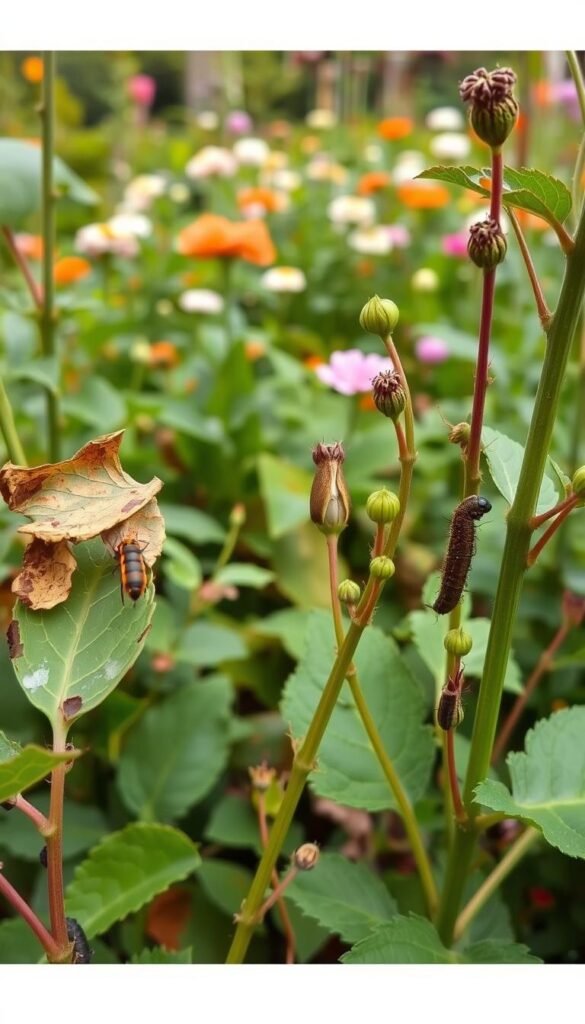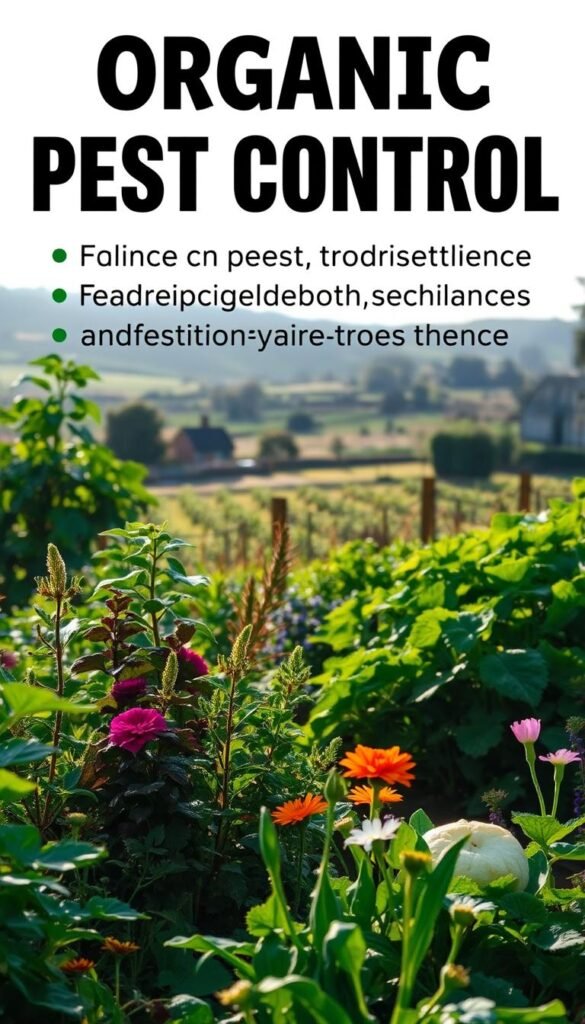Transform your green space into a resilient habitat where helpful insects and plants work together. Instead of battling unwanted visitors with harsh chemicals, you’ll learn to work with nature’s rhythms for lasting results. This approach helps you address issues early while supporting pollinators and soil health.
Timing is everything. Spring’s tender seedlings need different protection than summer’s blooming crops. By understanding your local ecosystem, you’ll spot patterns and make smarter choices about when to act. For example, adding flowering herbs like dill or yarrow attracts ladybugs that devour aphids naturally.
Discover how simple changes yield big rewards. Healthy soil packed with compost creates stronger plants that resist damage. Physical barriers like row covers offer non-toxic protection during vulnerable growth stages. If you’re dealing with stubborn invaders, targeted organic solutions can tackle problems without harming earthworms or bees.
You’ll gain practical methods that build resilience year after year. Whether it’s hand-picking cabbage worms or using soap sprays for mites, these strategies fit seamlessly into your routine. With patience, your outdoor area becomes a balanced environment where challenges become opportunities to grow—literally.
Understanding the Basics of Organic Pest Management
Creating a healthy garden ecosystem begins with understanding nature’s pest control systems. Instead of quick fixes, you’ll focus on long-term balance that keeps plants thriving. This means accepting some insects as part of your garden’s natural checks and balances.
Integrated Pest Management (IPM) guides your strategy through six steps. Start by identifying exactly what’s munching on your plants—many bugs are harmless or even helpful. Next, learn their life cycles to strike when they’re most vulnerable.
| Step | Action | Key Focus |
|---|---|---|
| 1 | Identify pests & damage | Avoid misdiagnosis |
| 2 | Study life cycles | Timing interventions |
| 3 | Monitor populations | Track changes weekly |
| 4 | Set damage limits | Prevent overreaction |
| 5 | Choose techniques | Start least invasive |
| 6 | Review results | Adjust future plans |
Why wait until pests overrun your tomatoes? Regular monitoring lets you spot issues early. Set a “damage threshold”—maybe losing 10% of leaves is okay if it means birds get snacks.
These methods do double duty. Companion planting deters pests while attracting pollinators. Healthy soil grows stronger plants that shrug off invaders. With practice, you’ll spend less time battling bugs and more enjoying your green oasis.
Recognizing Seasonal Pest Threats in Your Garden

Your garden’s success depends on anticipating nature’s schedule. Different times of year bring unique insect behaviors that impact your plants. By staying one step ahead, you’ll protect your greens without disrupting beneficial species.
Spring’s Hidden Dangers
Early growth stages face sneaky attackers. Aphids swarm tender shoots when temperatures rise, while cutworms slice through stems overnight. Check leaf undersides weekly—sticky residue or chewed edges signal trouble.
Fall’s Quiet Invaders
Cooler weather drives pests to seek winter homes. Beetles burrow into soil, and moths lay eggs in plant debris. Clear fallen leaves promptly—this simple habit disrupts their life cycles dramatically.
| Season | Top Concerns | Smart Responses |
|---|---|---|
| Spring | Aphids, cutworms, slugs | Introduce ladybugs, use cardboard collars |
| Autumn | Grubs, spider mites, cabbage worms | Apply diatomaceous earth, remove decaying matter |
Timing treatments matters more than frequency. Apply nematodes in early spring when soil reaches 55°F. Set up sticky traps before peak flying seasons. These small adjustments yield big protection.
Organic Pest Management: Seasonal Approaches to Common Garden Threats

Think of your backyard as a living network where every creature has a purpose. This permaculture perspective transforms your space into a self-regulating system. Instead of fighting nature, you’ll nurture relationships that keep problems in check naturally.
Defining Your Garden Ecosystem
Your green space thrives when soil microbes, plants, and predators work together. Strong roots from compost-rich earth create resilient plants that resist damage. Predatory insects like lacewings handle aphids, while birds snack on caterpillars—no chemicals needed.
Start by mapping your space’s unique conditions:
- Note sunlight patterns and soil type
- Identify native plants that attract helpful species
- Track where pests typically appear
Diversity is your ally. Mix flowers with veggies to confuse pests and invite pollinators. Marigolds repel nematodes, while dill houses ladybug larvae. For stubborn issues, targeted organic strategies offer backup without harming your ecosystem’s balance.
Observe daily—you’ll spot partnerships you never noticed. A thriving green space isn’t pest-free; it’s a place where nature handles challenges through clever teamwork.
Cultural Practices for Preventing Pest Problems

Smart gardening starts with outsmarting pests before they become a headache. Simple shifts in how you arrange and rotate plants create natural defenses that last for seasons. These time-tested strategies work with your garden’s biology to keep unwanted visitors guessing.
Crop Rotation and Companion Planting
Switching plant families yearly breaks pest life cycles like a pro. Corn rootworms can’t survive if you swap corn with soybeans or oats for 1-2 years. Larger spaces see the best results, but even small plots benefit from smart swaps.
Plan your garden layout three years ahead. Avoid planting tomatoes where peppers grew last season—both attract similar bugs. Mix in flowers like marigolds near veggies to repel nematodes naturally. Basil makes peppers less appealing to aphids while boosting their flavor.
| Year | Bed A | Bed B |
|---|---|---|
| 1 | Corn | Beans |
| 2 | Squash | Oats |
| 3 | Peppers | Marigolds |
Short on space? Try vertical gardening or interplanting herbs with vegetables. These natural ways to protect your crops build soil health while saving you time. You’ll spend fewer weekends fighting infestations and more enjoying your thriving plants.
Mechanical and Physical Control Techniques

Take charge of garden invaders with hands-on solutions that stop damage before it spreads. These non-chemical strategies let you tackle problems immediately while keeping your growing area safe for pollinators and soil life.
Hand-Picking and Manual Removal
Early morning dew makes beetles sluggish and easier to spot. Carry a bucket of soapy water to drop offenders into—effective for tomato hornworms and squash bugs. Check leaf undersides for shiny egg clusters, scraping them off with a dull knife.
Setting Up Physical Barriers and Traps
Floating row covers shield young plants from flying insects. Secure edges with rocks or soil to block entry points. Yellow sticky traps catch whiteflies, while pheromone lures disrupt mating cycles for beetles.
Time your defenses wisely. Install plant collars when transplanting seedlings to stop cutworms. A strong hose spray knocks aphids off roses every 3-4 days. Beer traps sunk to ground level outsmart slugs better than chemicals.
These methods work best when matched to pest habits. You’ll save time and protect crops without disrupting your garden’s natural balance.
Harnessing the Power of Biological Controls

Your garden becomes a self-regulating sanctuary when you team up with nature’s built-in pest patrol. These living solutions work 24/7, turning leaf-munchers into meals for their natural enemies. It’s about creating partnerships where every creature plays its part.
Attracting Beneficial Insects
Ladybugs aren’t just cute—they’re aphid-eating machines. A single adult can devour 50 soft-bodied pests daily. Plant yarrow, dill, or cosmos to invite them. These flowering heroes provide nectar and shelter, encouraging ladybugs to lay eggs near trouble spots.
Utilizing Natural Predators
Not all helpers look friendly. Lacewing larvae—called “aphid lions”—have pincers that make quick work of infestations. Parasitic wasps are even sneakier. They lay eggs inside pests like caterpillars, letting their young eliminate threats from within.
Create predator-friendly zones with these essentials:
- Shallow water dishes with pebbles for drinking
- Undisturbed brush piles for winter shelter
- Diverse blooms that flower throughout seasons
Timing matters most. Release purchased beneficial insects when you spot early pest activity. For balcony growers, eco-friendly pest control solutions work wonders in tight spaces. Monitor populations weekly—a few aphids sustain your allies, but outbreaks need quick action.
“Biological controls aren’t instant fixes—they’re investments in your garden’s future resilience.”
Patience pays off. Within 2-3 seasons, you’ll notice fewer outbreaks as nature’s balance takes hold. Your role shifts from combatant to conductor, guiding an orchestra of organisms that protect your plants.
Implementing Chemical Controls When Necessary
Even the best-planned gardens sometimes need a helping hand to manage persistent pests. When cultural and biological methods fall short, select natural solutions can provide targeted relief without harming your garden’s balance. These options work best when used sparingly and strategically.
Neem oil stands out as a versatile spray that tackles both insects and fungal issues. Mix 1 teaspoon with water and a drop of dish soap for weekly applications under leaves—this stops aphids and spider mites. For beginners, simple natural solutions like this offer gentle yet effective control.
Food-grade diatomaceous earth (DE) works differently. Its microscopic edges damage soft-bodied pests’ exoskeletons upon contact. Apply it dry around plant bases, but rinse harvests thoroughly. Bacillus thuringiensis (Bt) takes precision further—specific strains target caterpillars or beetles while sparing bees.
Always use these chemicals thoughtfully. Spray at dawn or dusk when pollinators rest. With careful timing and measured doses, you’ll resolve outbreaks while keeping your garden’s ecosystem thriving.






